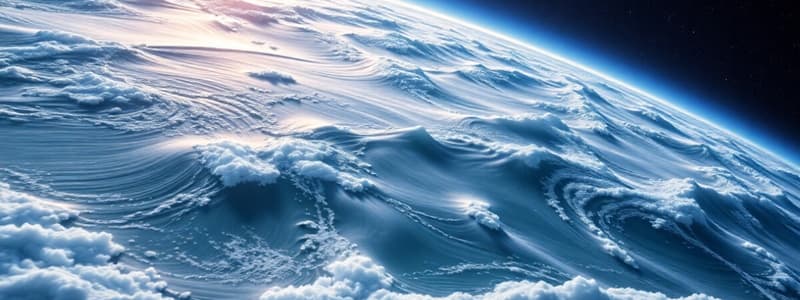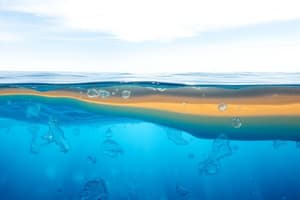Podcast
Questions and Answers
The biosphere is the only sphere of Earth considered to be abiotic.
The biosphere is the only sphere of Earth considered to be abiotic.
False (B)
The mesosphere is the layer of the atmosphere closest to the surface of the Earth.
The mesosphere is the layer of the atmosphere closest to the surface of the Earth.
False (B)
The hydrosphere includes all water on Earth, including water molecules composed of three hydrogen atoms and one oxygen atom.
The hydrosphere includes all water on Earth, including water molecules composed of three hydrogen atoms and one oxygen atom.
False (B)
Thermohaline circulation, also known as the Global Conveyor Belt, is driven by changes in water temperature and density.
Thermohaline circulation, also known as the Global Conveyor Belt, is driven by changes in water temperature and density.
The Earth's mantle is the thinnest layer, making up the livable area of the Earth.
The Earth's mantle is the thinnest layer, making up the livable area of the Earth.
Tectonic plates are pieces of the lithosphere, which includes part of the Earth's crust and the upper mantle together.
Tectonic plates are pieces of the lithosphere, which includes part of the Earth's crust and the upper mantle together.
The Earth's inner core is liquid iron due to extremely high temperatures.
The Earth's inner core is liquid iron due to extremely high temperatures.
The mesosphere is known for burning up most meteors.
The mesosphere is known for burning up most meteors.
The exosphere is the layer of the atmosphere where weather occurs.
The exosphere is the layer of the atmosphere where weather occurs.
Nitrogen is the most abundant gas in the Earth's atmosphere.
Nitrogen is the most abundant gas in the Earth's atmosphere.
Surface currents in the ocean are mainly influenced by the temperature differentials.
Surface currents in the ocean are mainly influenced by the temperature differentials.
Carbon dioxide is a trace gas that plays a key role in the greenhouse effect.
Carbon dioxide is a trace gas that plays a key role in the greenhouse effect.
Commercial jets fly primarily in the troposphere.
Commercial jets fly primarily in the troposphere.
Deep water currents are affected by the Coriolis effect.
Deep water currents are affected by the Coriolis effect.
Ozone in the stratosphere helps block harmful ultraviolet light.
Ozone in the stratosphere helps block harmful ultraviolet light.
Flashcards
Thermohaline Circulation
Thermohaline Circulation
The process of ocean currents being driven by differences in water temperature (thermo) and salinity (haline).
Earth's Spheres
Earth's Spheres
The interconnected system of Earth's air, water, land, and living organisms.
Exosphere
Exosphere
The outermost layer of the Earth's atmosphere, extending into space. It's where satellites orbit.
Stratosphere
Stratosphere
Signup and view all the flashcards
Earth's Crust
Earth's Crust
Signup and view all the flashcards
Troposphere
Troposphere
Signup and view all the flashcards
Earth's Mantle
Earth's Mantle
Signup and view all the flashcards
Thermosphere
Thermosphere
Signup and view all the flashcards
Current
Current
Signup and view all the flashcards
Ocean Currents
Ocean Currents
Signup and view all the flashcards
Coriolis Effect
Coriolis Effect
Signup and view all the flashcards
Study Notes
Earth's Atmosphere
- Earth's atmosphere is a thin layer of gases surrounding the planet, divided into five layers: troposphere, stratosphere, mesosphere, thermosphere, and exosphere.
- The troposphere is the lowest layer, where weather occurs and life resides.
- The stratosphere is above the troposphere, where commercial jets fly; it's a relatively calm layer.
- The mesosphere is a cold layer where many meteors burn up.
- The thermosphere is a thin, cloudless layer, high above.
- The exosphere is the outermost layer, where the atmosphere merges with outer space; most satellites orbit here.
- The two most abundant gases are nitrogen (78%) and oxygen (21%).
- Remaining 1% consists of water vapor (variable), argon, carbon dioxide, and trace gases like ozone and methane.
- Stratospheric ozone blocks harmful UV light.
- Methane and carbon dioxide are greenhouse gases, trapping heat and warming the Earth.
Ocean Currents
- Ocean currents are large-scale movements of water across the globe.
- Two main types: surface currents and deep-water currents.
- Surface currents are primarily driven by wind and the Coriolis effect.
- The Coriolis effect deflects currents; clockwise in the Northern Hemisphere, counter-clockwise in the Southern.
- Deep-water currents are driven by density differences in water.
- Density changes are due to variations in temperature and salinity.
- Denser water sinks, causing warmer and less dense water to rise.
- This movement is called thermohaline circulation, or the Global Conveyor Belt, distributing nutrients and energy.
Earth's Spheres
- Earth's four spheres (atmosphere, biosphere, geosphere, hydrosphere) interact and are interconnected.
- Atmosphere is all air on Earth, with five layers.
- Biosphere contains all life (plants, animals, microorganisms).
- Geosphere is Earth's solid land, consisting of layers like the inner core, outer core, mantle, and crust.
- Hydrosphere is all water on Earth, composed of hydrogen and oxygen.
- Human activities impact interactions between these spheres.
Earth's Structure
- Earth has three main layers: crust, mantle, and core.
- Crust is the outermost, thinnest, and the layer we live on.
- Mantle is the thickest layer, made of molten rock and minerals, flowing in a convection pattern.
- This movement causes earthquakes and volcanic activity. Tectonic plates are pieces of the lithosphere.
- Core consists of an outer liquid iron layer and an inner solid iron layer under immense pressure.
- Gravity caused dense materials to sink to Earth's center.
Studying That Suits You
Use AI to generate personalized quizzes and flashcards to suit your learning preferences.




